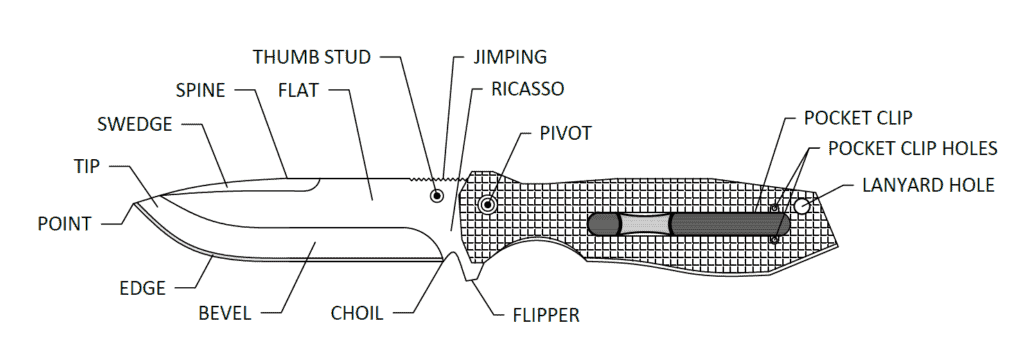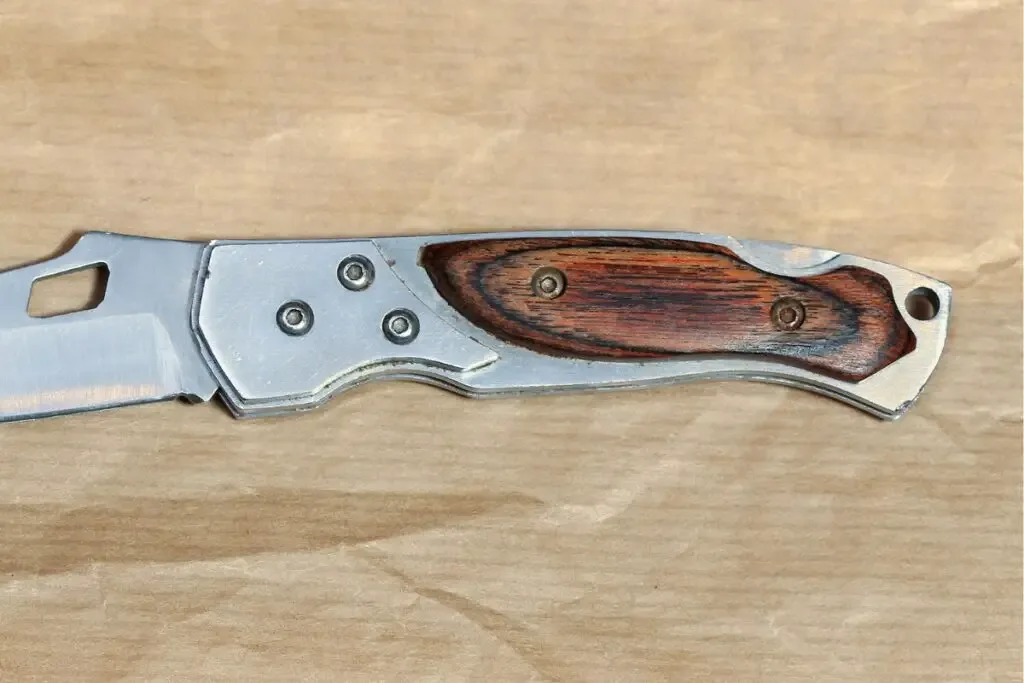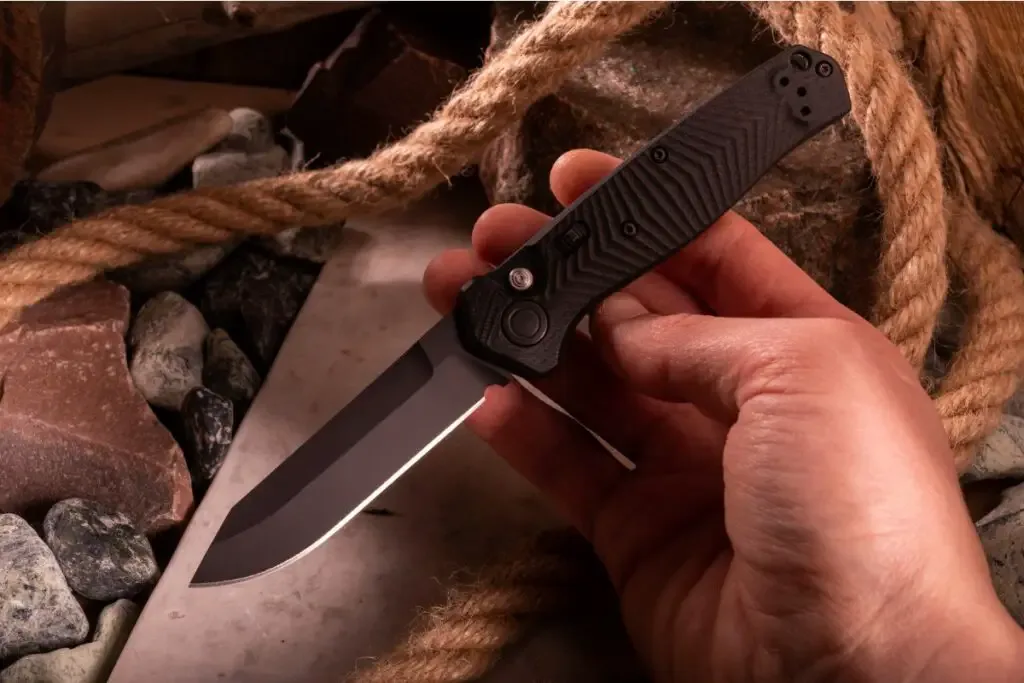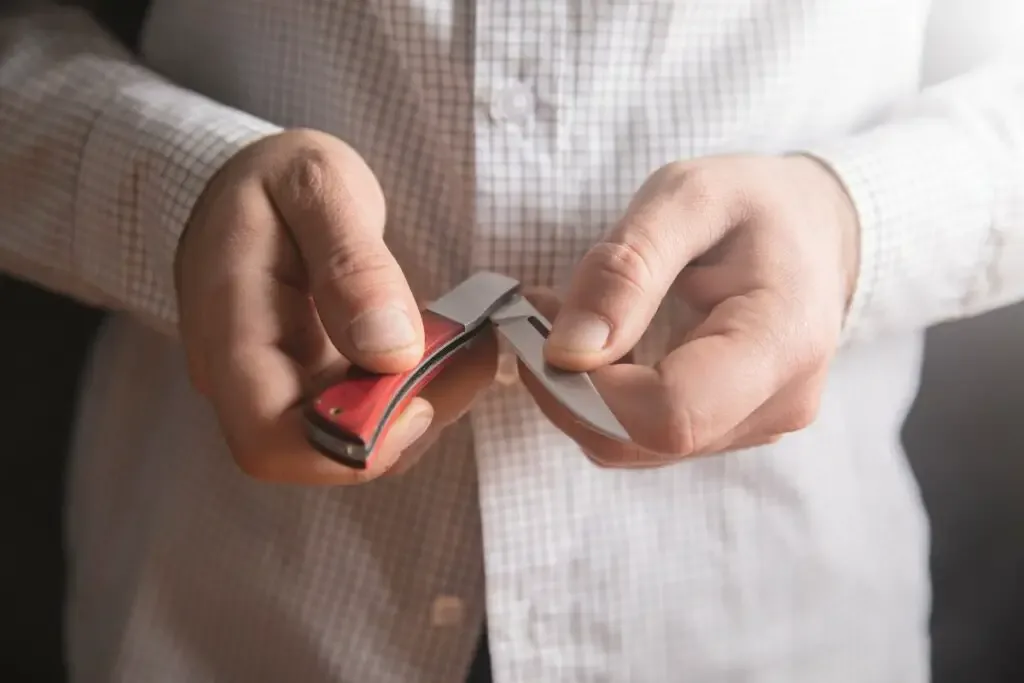As an Amazon Associate, we earn from qualifying purchases with no additional costs for you.
All knives have basic parts in common. Such as a blade, handle and a sharp cutting edge. Pocket knives are quite unique in that they may be different in size and functionality, but they all consist of mostly the same parts. Though there can be differences between these knives – even when they’re from the same manufacturer. The biggest difference you’re likely to find is in the locking mechanisms, as there are a wide variety.
A pocket knife generally consists of the blade, tip, handle/tang, handle scales, spine, pivot point, liners, thumb stud, spring, flipper, pocket clip and most importantly the cutting edge (to name a few). Sitting snugly in your pocket are all these parts, perfectly assembled for your use.
We’ll examine a few crucial parts of your pocket knife, focusing on what they’re called and their specific function. We’ll also take a look at dividing your knife into its main parts. Giving you a detailed overview of your knife.
If you are interested in checking out different amazing Victorinox knives you can find them by clicking here (Amazon link).

What Are The Parts of a Pocket Knife?
There are at least 18 different parts in your average pocket knife. But for now, you only have to worry about 3 main parts. Namely, the blade, your handle, and the sides or scales.
These are the main parts that every pocket knife, without fail, will have in them. But there are a total of 18 different parts that you may want to know about – let’s explore.

What Are The Blades on a Pocket Knife Called?
The blade of your pocket knife can have many different names, depending on it’s style.
Simply calling it a ‘blade’ is perfect – but if you want to get technical, some of the popular knife blades are the drop point, tanto, clip point, and bowie – to name only a few.
Which blade you choose is largely dependent on what style you find appealing, as well as the purpose of your knife.
The average blade consists of and houses different parts of the pocket knife. For example, you have your tip, point (yes, two different things), edge, swedge, spine, bevel, flat, choil, thumb stud, and ricasso.
- Tip
The tip of your knife is the forward-most part of your knife. It’s main purpose is to pierce whatever it is you need to cut.
For example, if you need to cut a hole out of the middle of a blanket, your tip (along with your point) makes it easier to stab through the material.
- Point
The point of your knife is just back from the tip, where the edge and the spine meet. Other than piercing, mentioned above, your point is just a by-product of the knife’s construction.
- Edge
The edge of your knife is normally the sharpest part that runs from the tip all the way to the ricasso. It’s what does all the cutting work, and hence is the most important part – it’s what makes your knife a knife in the first place.
- Swedge
The swedge doesn’t appear on all knives, but it’s purpose varies. In Swiss army style knives, it allows an opening to the nail pulls that help you unfold the different tools.
On normal pocket knives, however, they’re mostly for visual appeal but can also be to make cutting easier by making the knife’s overall profile thinner.
- Spine
The spine is the top of your knife blade – it sits on the other end as your edge. Depending on the style of knife, the spine could be flat but also feature curves.
Your bevel is between the edge and the spine of the knife (usually). It’s where the spine starts angling down to create the edge.
Depending on the style of knife, you could either have a single bevel (one side ground down to meet the other) or a double bevel (both sides ground down to meet in the middle).
Thumb Stud of the Blade
Next, we’ll look at the thumb stud, which is at the top of the blade near the handle. It can be on one or both sides of the blade and is used to flick the blade open quickly.
- Ricasso
The ricasso is the unsharpened piece between the handle and the blade. Its use is debated amongst knife enthusiasts, but its most common purpose in the modern age is to allow sharpening of the edge without damaging the handle of your knife.
Though the ricasso is not all that common in pocket knives, since most feature a choil instead. (The ricasso can still be present, but higher up from the edge on pocket knives).
- Choil
The choil is a notch between the edge and the handle, which allows the full length of a blade to be sharpened. This is useful when you have a smaller blade on your knife – such as with a pocket knife.
TIP: Lubricating your pocket knife can add years to its lifetime. Find out how to properly lubricate your pocket knives in the article below:
Lubricating a Pocket Knife in Three Steps: Can You Use WD-40?
What Is The Handle of a Pocket Knife Called?

The handle of your pocket knife is, quite simply, the handle – though it is sometimes referred to as scales or even grip.
“Scales” can be confusing at times, because most assume the scales are the outer layers of the handle, but the scale is actually a metal plate inside your handle construction.
- Scales
The scales ensure a tight fit for your folding blade.
- Handle itself
The handle itself can consist of only the outer handle and the tang, which is found in fixed-blade knives. The tang is the part of the knife that goes into the handle.
It’s not often found in pocket knives, as most would rather feature a pivot than some form of partial tang.
- Pivot
The pivot is the folding mechanism that allows your knife to open and close. It’s where the blade meets the handle, and is often covered by the handle itself.
There are many more handle parts, depending on the style of knife you choose. For example, the handle of a Swiss army knife would be way more complicated than a simple folding knife.
Some of these components include the bolsters, springs, and pins. These are all held together by either rivets or screws. The handle will also usually have a jimping (the ‘grip’ part on the spine near where your knife folds) and the locking mechanism.
Some pocket knives even have lanyard holes, and most will have a pocket clip attached to them – for quick and easy pocket storage.
TIP: Clip-on pocket knives are very useful feature, but it often happens that the clip bends. Find out how to fix a bent pocket knife clip in a few simple steps in the article below:
DIY: Fixing a Bent Pocket Knife Clip in THREE EASY STEPS
When it comes to fixed blade knives, the handle construction can be much simpler – usually consisting of either the hidden tang and a solid handle or a full tang and a grip on either side of the tang – again, held together by either rivets, screws or even epoxy (though rivets are preferred in fixed blade knives).
The main advantage of rivets is that you’ll get a more solid knife that’s less likely to come apart while in use, but screws make it easier to take apart and fix your knife yourself.
Covers (the outer visible layer of your handle) come in a variety of shapes, colors, and materials. A high-quality handle is important and ensures your grip stays tight and true.
Each type of material has its own advantages in regard to comfort and performance. Although personal preference and aesthetics will largely dictate what you decide on.
Some common materials include wood, deer antlers, or synthetic handles (everything from plastic and polymer to aluminum).
The entire part of the knife that you hold is known as a handle, with all the above parts being possibilities within, depending on the type of knife. The pocket knife handle will also house the blade when your knife is folded, acting as a sort of sheathe.
Since we’re at the end of this section, let’s talk about the butt. The butt of your knife is the very end of the handle and can often feature a small spike that’s handy for breaking through glass (such as when you were in an accident of some sort and had to escape through shatterproof glass).
TIP: Whether the knife is easy or difficult to sharpen depends on the type of steel of the knife blade. In the article below you will find the types of steels that are easy to sharpen.
List of The Easiest Knife Steels To Sharpen (With Examples)
What Are The Sides of a Pocket Knife Called?

It depends on how you’re looking at the knife. With a side-on view, the sides would be your spine and edge and/or blade housing (in the case of a pocket knife).
Looking at your knife from the blade or spine side, the sides would simply be the handle referred to above.
We’re going to cover the spine and blade since there’s no more to say about the handle.
The blade-side of your knife will usually consist of the edge itself, a ‘flipper’ (the part that can be used to quickly unflip your knife and doubles as a finger stop), the choil (between the blade and the flipper), and the lock (on some pocket knives).
Looking at your pocket knife from the blade angle with the blade open, you should also be able to see the spacers (commonly tube spacers) that keep the two sides of your handle together and, at the same time, make space for your blade.
You’ll also be able to see various components we’ve already covered, including the pocket clip, thumb stud, and pivot.
The spine of your knife will usually have the spine of the blade itself, the swedge, and the jimping (the grooves cut into the back of the knife that add grip) visible to you.
You’ll also most commonly see the locking mechanism as well as the backspacer – which is the solid part between the two handles.
BTW: If you want to know more about Japanese and other knives and their sharpening, check out the books listed above. These books are recommended by professional sharpeners and knife makers (Amazon links):
- Japanese Kitchen Knives: Essential Techniques and Recipes
- The Knifenerd Guide to Japanese Knives
- Knife: The Culture, Craft, and Cult of the Cook’s Knife
- Sharp: The Definitive Introduction to Knives, Sharpening, and Cutting Techniques, with Recipes from Great Chefs
Understanding Pocket Knife Mechanics: A Closer Look at Functionality

Pocket knives are marvels of mechanical engineering, combining multiple components in a compact and foldable design. Understanding the mechanics of a pocket knife is crucial for optimal usage, maintenance, and safety. It allows users to appreciate the intricate design and functionality that go into creating these versatile tools.
Blade Deployment Mechanism
One of the fundamental mechanics of a pocket knife is the blade deployment mechanism. It allows the blade to be opened and closed smoothly and securely. The pivot point is crucial in this mechanism, acting as the folding axis around which the blade rotates. The deployment can be facilitated by thumb studs or flippers, allowing for quick and easy one-handed opening.
Locking Mechanism
The locking mechanism is another vital component, ensuring the blade stays in place when opened, preventing accidental closures that can lead to injuries. Various locking mechanisms exist, such as liner locks, frame locks, and lockbacks, each with its unique method of securing the blade.
Spring Mechanism
Some pocket knives feature a spring mechanism, enabling assisted opening or automatic deployment of the blade. This mechanism relies on tension stored in a spring, which is released when the user activates the deployment mechanism, propelling the blade open.
Handle Construction
The handle houses several components, including the scales, liners, and spacers, which contribute to the overall stability and durability of the knife. The handle also often features a pocket clip for secure carrying and may include additional tools and features, depending on the design.
Blade Geometry and Edge Mechanics
The blade’s geometry, including the bevel, edge, spine, and tip, plays a significant role in the knife’s cutting ability and performance. The edge mechanics, including sharpness and grind type, determine the knife’s suitability for various cutting tasks and its ease of sharpening.
Balancing and Ergonomics
The balance between the blade and the handle is crucial for user comfort and control. Proper ergonomics, including handle shape and texture, ensure a secure grip and reduce hand fatigue during prolonged use.
Maintenance Mechanics
Understanding the mechanics also extends to maintenance. Knowing how each part interacts helps in proper cleaning, lubrication, and tightening or loosening of screws, ensuring the longevity and optimal performance of the pocket knife.
Understanding the mechanics of a pocket knife provides insights into its functionality, usage, and maintenance. It allows users to appreciate the intricate design, make informed purchasing decisions, and use the tool safely and efficiently. A well-understood tool is a well-maintained one, and a well-maintained pocket knife can be a lifelong companion, ready to assist in various everyday tasks.
Now You Know
Now that you know all the parts of your average pocket knife, you can expertly tell any smith what’s wrong with your blade. We hope this article has been especially helpful and that you’ll keep safety top of mind always when handling a pocket knives.
TIP: If you want to have your pocket knife in good shape it has to be sharp. In the article below you will find the 4 best sharpeners for your pocket knife!
The 4 Best Knife Sharpeners For Pocket Knives
